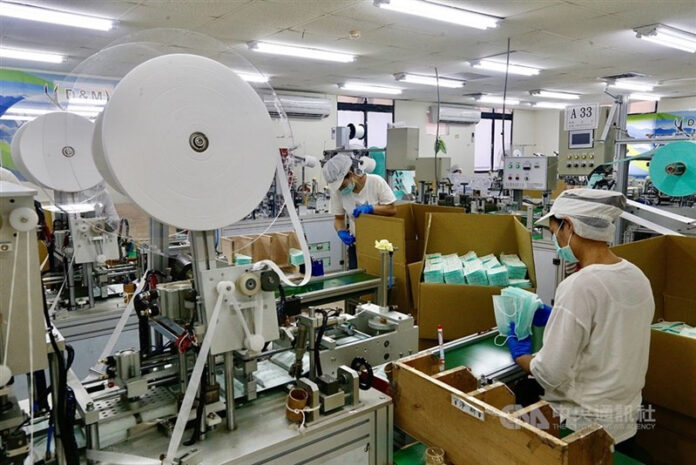Taiwan’s Manufacturing Activity Shows Positive Growth Amid Rising Export Orders
Manufacturing activity in Taiwan saw a significant recovery in November, returning to expansion after a period of stagnation. According to the Chung-Hua Institution for Economic Research (CIER), foreign clients rushed to place orders with Taiwan’s export-oriented manufacturers, driven in part by concerns over potential tariff changes under U.S. President-elect Donald Trump’s administration.
The Taiwan Purchasing Managers’ Index (PMI), a key indicator of manufacturing activity, rose to 51.4 in November, marking a 1.4-point increase from October. This signals a return to expansion, as readings above 50 indicate growth. The non-manufacturing index (NMI), which reflects activity in the service sector, also showed an uptick, rising to 54.6, continuing its 25th consecutive month of expansion.
Key Factors Driving the Manufacturing Expansion
The November PMI revealed several key drivers behind the sector’s recovery:
- New orders surged by 3.6 points, reaching 55.5, as foreign clients placed rush orders with Taiwanese electronics and optoelectronics manufacturers.
- Production and inventories also saw positive movement, with the production index rising by 4.0 points to 54.5, signaling an increase in output.
- However, the employment and supplier delivery subindexes showed slight declines, suggesting that while demand is rising, there remain challenges in workforce expansion and supply chain efficiency.
Trump’s Effect on Taiwanese Exports
The strong increase in new orders is largely attributed to the “Trump effect,” with foreign clients, particularly in the electronics sector, looking to secure products before potential tariff hikes that could affect trade between the U.S. and countries with large trade surpluses, including Taiwan. Manufacturers are facing heightened uncertainty, particularly as Trump prepares to take office.
Cautious Outlook for the Next Six Months
Despite the positive performance in November, CIER President Lien Hsien-ming expressed caution about the outlook for the coming months. The business outlook subindex for the next six months fell to 47.9, indicating a shift into contraction. Many manufacturers are adopting a wait-and-see attitude, awaiting clarity on U.S. trade policy once Trump takes office.
CIER economist Chen Hsin-hui noted that while many manufacturers secured rush orders, the sustainability of these orders remains uncertain, as they are not necessarily long-term commitments.
Performance Across Industries
CIER’s data showed a mixed performance across industries in November:
- Electronics and optoelectronics manufacturers remained in contraction, reflecting ongoing struggles in some segments of the tech industry.
- Chemical and biotech industries returned to expansion mode, along with the basic raw materials sector.
- Transportation equipment and food and textile industries showed declines in their PMI subindexes, with the food sector remaining on the edge between expansion and contraction.
Service Sector Continues Growth
In the non-manufacturing sector, Taiwan’s service industries continued to perform well in November, with business activity and new orders both showing strong increases. However, employment and supplier deliveries experienced slight drops, which are indicative of some challenges in the service sector.
The business outlook for the next six months in the service sector fell slightly to 50.6, but remained in expansion, marking the 13th consecutive month of growth.
Table: Taiwan’s Key Economic Indicators for November
| Indicator | November Data | Change from October | Trend |
|---|---|---|---|
| PMI (Manufacturing) | 51.4 | +1.4 | Expansion |
| NMI (Non-Manufacturing) | 54.6 | +0.8 | Expansion |
| New Orders (PMI) | 55.5 | +3.6 | Expansion |
| Production (PMI) | 54.5 | +4.0 | Expansion |
| Employment (PMI) | 50.3 | -1.4 | Contraction |
| Supplier Deliveries (PMI) | 48.3 | -0.5 | Contraction |
| Business Outlook (PMI) | 47.9 | -0.4 | Contraction |
| Business Activity (NMI) | 55.2 | +1.4 | Expansion |
| New Orders (NMI) | 54.8 | +3.7 | Expansion |
| Business Outlook (NMI) | 50.6 | -0.9 | Expansion |
Conclusion: Cautious Optimism in Taiwan’s Economy
While the November PMI data shows a positive rebound in Taiwan’s manufacturing sector, the outlook remains cautious. Manufacturers remain wary of future challenges, especially concerning potential U.S. trade tariffs and uncertainty in the global market. As Taiwan’s economy heads into the final months of 2024, it will be crucial for businesses to closely monitor the policies of President-elect Trump and other geopolitical developments that could impact Taiwan’s export-driven economy.
FAQs: Taiwan’s Manufacturing Activity in November
- What does the PMI rise indicate?
- The rise in Taiwan’s PMI to 51.4 indicates that manufacturing activity has returned to expansion mode after a period of stagnation.
- Why did new orders increase in November?
- The increase in new orders was driven by foreign clients rushing to place orders with Taiwanese manufacturers ahead of potential U.S. trade tariffs under President-elect Trump.
- What sectors are performing well in Taiwan’s economy?
- Electronics, optical electronics, and chemical industries showed signs of improvement, while some other sectors, such as transportation equipment, faced challenges.
- What is the outlook for Taiwan’s economy in the next six months?
- The outlook remains cautious, with many manufacturers uncertain about the impact of U.S. trade policies under President-elect Trump.
- What is the significance of the NMI index?
- The NMI shows the performance of Taiwan’s service sector, which continued its growth in November, despite some declines in certain subindexes like employment and supplier deliveries.
